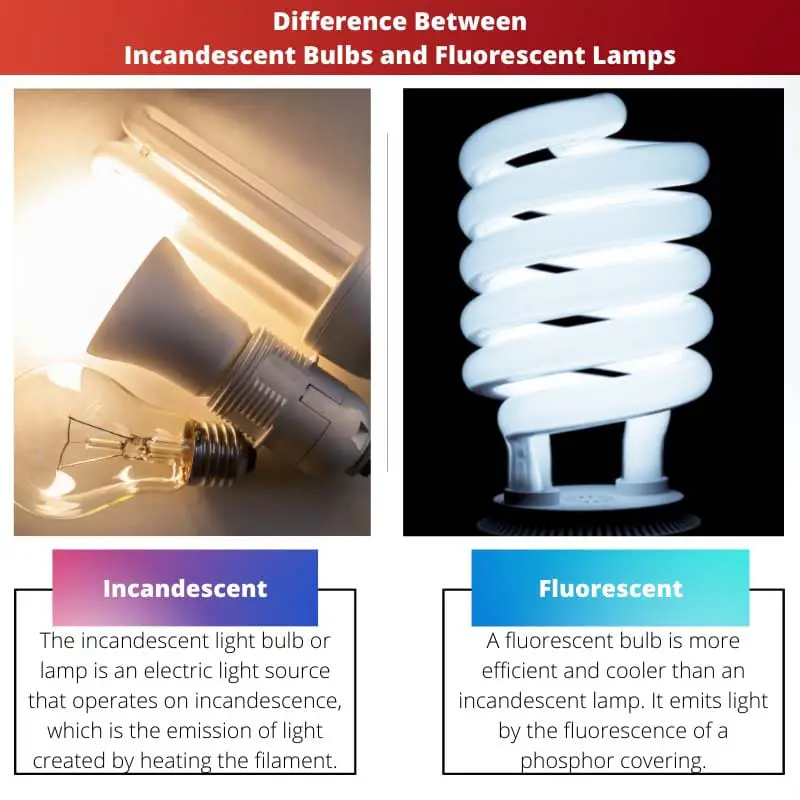We require illumination in every setting in which we live, from our homes to our offices to our streets and automobiles. These light fixtures differ in how they create light and how much power they require.
Incandescent bulbs and fluorescent lights are the two most prevalent types of lighting fixtures nowadays.
Key Takeaways
- Incandescent bulbs use a filament that heats up to produce light.
- Fluorescent lamps use an electric discharge to excite the gas and create light.
- Incandescent bulbs have a shorter lifespan and are less energy-efficient than fluorescent lamps.
Incandescent Bulbs vs Fluorescent Lamps
Incandescent bulbs pass an electric current through a thin tungsten filament encased in a glass bulb filled with inert gas. Fluorescent lamps work by passing an electric current through a gas-filled tube coated with phosphorescent material, making it more efficient.

An incandescent bulb produces light by heating a filament made of metal. It is less efficient than a fluorescent bulb as it lasts for a lesser time and also consumes more electricity, even if they have to produce the same amount of light.
They are more affordable than fluorescent lamps.
A fluorescent lamp generates light via the excitation of a gas, which causes it to glow. It is more efficient than an incandescent bulb since it produces less heat and lasts longer.
When compared to an incandescent bulb, it utilizes less power. Despite all of its benefits, it is more expensive than an incandescent bulb.
Comparison Table
| Parameters of Comparison | Incandescent Bulbs | Fluorescent Lamps |
|---|---|---|
| Method of Light Production | Light is produced by heating filament | Light is produced by gas discharge |
| Efficiency | Less Efficient | More Efficient |
| Amount of Heat Produced | A lot of heat is produced | Less heat is produced |
| Light Life | Do not last for a long time | Last for a longer time |
| Affordability | More affordable | Less affordable |
| Amount of Electricity Consumed | More electricity is consumed | Less electricity is consumed |
What are Incandescent Bulbs?
The incandescent light bulb or lamp is an electric light source that operates on incandescence, which is the emission of light created by heating the filament.
They are available in a broad range of sizes, wattages, and voltages. Incandescent bulbs were the first type of electric illumination and have been in use for over a century.
While Thomas Edison is commonly regarded as the creator of the incandescent light bulb, a number of others produced light bulb components and prototypes long before Edison.
An incandescent bulb is made out of a glass shell that houses a tungsten filament. An electric current flows through the filament, heating it to a temperature high enough to create light.
Incandescent light bulbs are frequently stemmed or have a glass mount attached to the underside, which allows the electrical components to flow through the enclosure without spilling gas or air.
To retain and protect the filament from evaporation, the surrounding glass enclosure includes either a vacuum or an inert gas.
Incandescent bulbs do not require external regulating equipment, have a relatively cheap production cost, and may operate on alternating or direct currents.
They may also be used indoors and outdoors and are compatible with control devices such as dimmers, timers, and photosensors. As a result, the incandescent lamp is extensively used in both domestic and commercial lighting.

What are Fluorescent Lamps?
A fluorescent bulb is more efficient and cooler than an incandescent lamp. It emits light by the fluorescence of a phosphor covering.
A fluorescent lamp is a tubular structure charged with argon and mercury vapour.
Metal conductors are coated with an alkaline earth oxide, which rapidly emits electrons at either end. When an electric charge is sent via gas between the electrode, it ionizes and emits UV light.
In modern compact fluorescent lamps (CFLs), the ballast is curled further into cups at the bottom of the bulb component,
and the fluorescent tube is curled into a shape similar to an incandescent bulb and is composed of electronic parts that significantly reduce the buzzing noise.
Even though the inclusion of ballast within every particular bulb affects the cost of the said bulb, the total amount to the operator is still cheaper compared to lower energy use and the CFL’s long-term stability.
Since a fluorescent lamp does not produce light by continuously burning, it uses up to one-quarter the influence of an incandescent bulb since it has a metallic filament.
Nevertheless, when the power is turned on it for the first time, up to four times the functional voltage of a fluorescent lamp is expected to ionize the gas

Main Differences Between Incandescent Bulbs And Fluorescent Lamps
- Incandescent bulbs emit light via a heated filament, whereas fluorescent lights emit light via a gas discharge.
- Incandescent bulbs are significantly less efficient than fluorescent lighting.
- When compared to fluorescent lamps, incandescent bulbs generate a lot of heat.
- Incandescent bulbs do not have the same lifespan as fluorescent lamps.
- Incandescent bulbs are significantly less expensive than fluorescent lighting.
- Incandescent light bulbs emit warmer light than fluorescent light bulbs.




